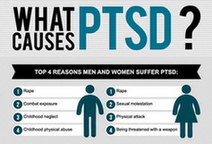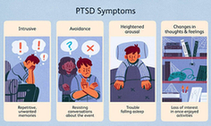Understanding the 10 Types of Mental Disorders
Post-Traumatic Stress Disorder(PTSD)
Understanding the Sixth of the 10 Types of Mental Disorders
A mental health disease known as post-traumatic stress disorder (PTSD) may have a significant effect on those who have gone through horrific experiences. We’ll dig into the complexities of PTSD in this essay, looking at its traits, symptoms, probable causes, and various therapies. By developing a greater knowledge of PTSD, we can help individuals who are struggling with it by increasing awareness, fostering empathy, and giving better support.
What Is Post-Traumatic Stress Disorder (PTSD)?
A traumatic incident can cause PTSD, a mental health disease that can arise after experiencing or witnessing one. These occurrences might include everything from mishaps and physical assault to natural calamities and exposure to conflict. People who have PTSD frequently deal with bothersome symptoms that linger and interfere with their daily life.
Advertisement
Characteristics and Symptoms
A variety of symptoms that are indicative of PTSD may be divided into four groups:
1. Intrusive Thoughts
These traumatic event-related memories, dreams, or flashbacks are upsetting. People could feel as though they are reliving the event.
2. Avoidance
persons who have PTSD may avoid situations, persons, or activities that bring up their terrible experience. Social exclusion and a feeling of alienation may result from this.
3. Negative Changes in Thinking and Mood
Negative alterations in mental processes and emotions might result from PTSD. People could have a hard time feeling happy emotions or feel guilty or ashamed of themselves.
4. Increased Arousal and Reactivity
People may be easily startled, have trouble falling asleep, and become irritable or angry. The effects of these symptoms on day-to-day functioning can be severe.
Impact on Daily Life
A person’s life may be significantly impacted by PTSD in a number of ways:
- Relationships: Emotional numbness and avoidance make it difficult to establish and sustain relationships.
- Work and Productivity: Increased arousal and intrusive thoughts lead to decreased productivity and attention problems.
- Quality of Life: Due to the traumatic nature of their symptoms, people with PTSD may have a worse than normal quality of life in general.
Potential Causes and Risk Factors
Accidents, attacks, battles, or natural catastrophes are examples of stressful events that might cause PTSD whether experienced or seen. PTSD development may be influenced by a number of factors, including:
- Trauma severity: The likelihood of having PTSD increases with trauma severity.
- Personal History: People who have a history of mental health issues or traumatic events may be more at risk.
- Lack of Support: Lack of social support might make PTSD more likely to occur.
Treatment Options
Effective therapies exist to support people in managing and coping with PTSD:
- Therapy: Cognitive behavioral therapy (CBT), especially prolonged exposure therapy and eye movement desensitization and reprocessing (EMDR), can assist people in processing traumatic memories and easing symptoms.
- Medication: To treat the symptoms of PTSD, doctors may give antidepressants and anxiety drugs.
Advertisement
Conclusion
After experiencing or witnessing horrific events, a complicated illness known as post-traumatic stress disorder (PTSD) may emerge. We can help to foster an atmosphere that is more accepting and encouraging for persons who are dealing with PTSD by having a better awareness of its traits, symptoms, and probable causes. Reducing stigma and building a greater understanding of this difficult mental health issue need taking efforts like seeking professional assistance, going through therapy, and raising awareness.







Pingback: Understanding the 10 Types of Mental Disorders - AFitHelp
Pingback: What Are the 10 Types of Mental Disorders - AFitHelp
Your comment is awaiting moderation.
– Ты знаешь, Иван, у меня сейчас едва удар от жары не сделался! Даже что-то вроде галлюцинации было… – он попытался усмехнуться, но в глазах его еще прыгала тревога, и руки дрожали. поиск интимных знакомств в интернете: обзор популярных сайтов и советы по безопасности Вследствие этого смертный приговор Га-Ноцри, вынесенный Малым Синедрионом, прокуратор не утверждает.